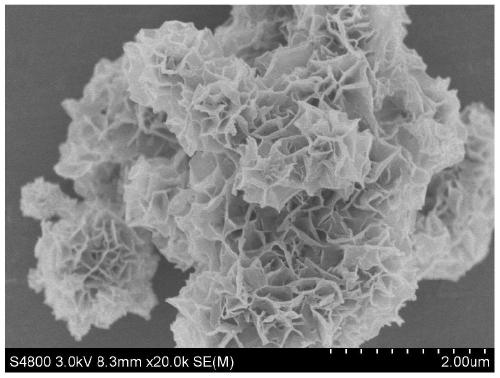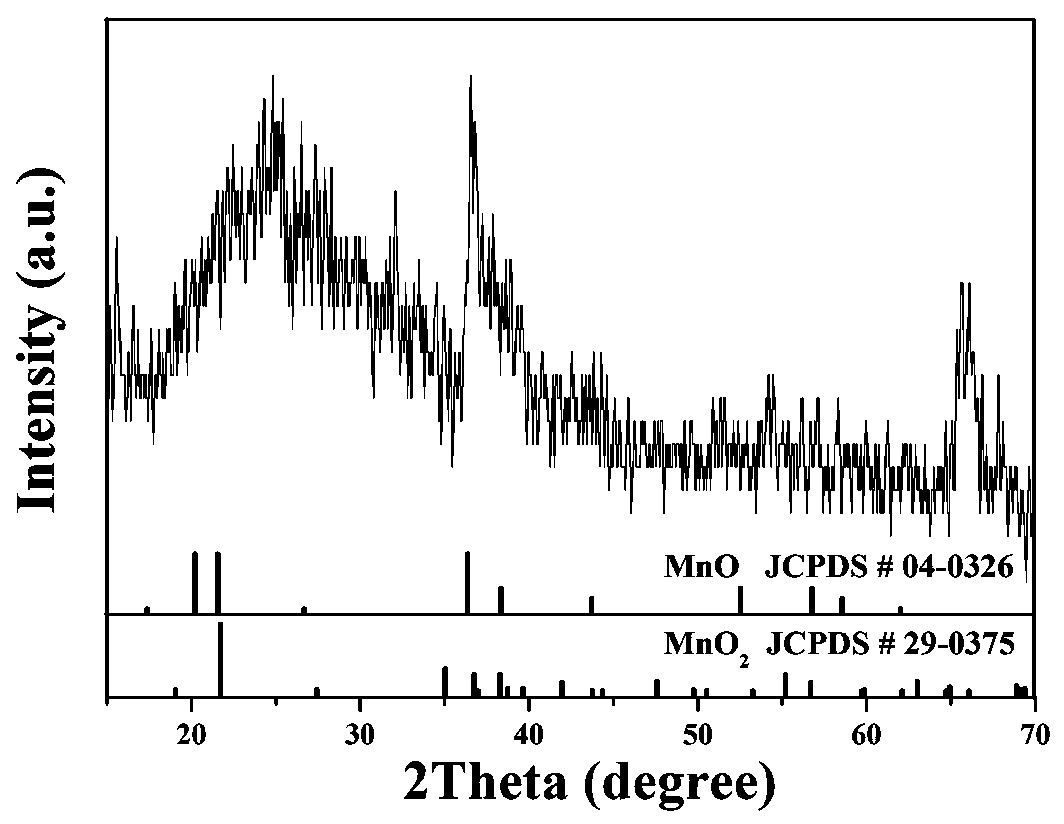MNO, a negative electrode material for sodium ion batteries x preparation method
A sodium-ion battery and negative electrode material technology, applied in battery electrodes, secondary batteries, circuits, etc., can solve the problems of difficult large-scale factory production, expensive graphene raw materials, complicated preparation process, etc., to achieve the benefit of embedding The effects of detachment, increased active specific surface area, and simple preparation process
- Summary
- Abstract
- Description
- Claims
- Application Information
AI Technical Summary
Problems solved by technology
Method used
Image
Examples
Embodiment 1
[0025] 1) getting manganese acetate and ammonium persulfate to be mixed with the manganese acetate solution of 0.12% and the ammonium persulfate solution of 0.11% in mass fraction respectively;
[0026] 2) Disperse the sodium lauryl sulfate in the manganese acetate solution, and magnetically stir until it is completely dissolved to prepare a mixed solution with a mass fraction of sodium lauryl sulfate of 1.96%;
[0027] 3) Take 60ml of ammonium persulfate solution and add it dropwise into 100ml of the mixed solution with a burette, and stir for 2 hours until the system is uniform;
[0028] 4) Move the homogeneously dissolved system to an ultrasonic cleaning machine with a power of 40W for ultrasonic treatment for 3 hours until a black precipitate is produced;
[0029] 5) The black precipitate obtained in step 4) is alternately washed with water and acetone, filtered, and dried to obtain MnOx, a negative electrode material for a sodium ion battery.
Embodiment 2
[0031] 1) getting manganese acetate and ammonium persulfate to be mixed with the manganese acetate solution that is 0.56% and the ammonium persulfate solution that massfraction is 0.75% respectively;
[0032] 2) Sodium lauryl sulfate is dispersed in the manganese acetate solution, and magnetically stirred until it is completely dissolved to prepare a mixed solution with a mass fraction of sodium lauryl sulfate of 3.5%;
[0033] 3) Take 60ml of ammonium persulfate solution and add it dropwise into 50ml of the mixed solution with a burette, and stir for 2 hours until the system is uniform;
[0034] 4) Move the homogeneously dissolved system to an ultrasonic cleaning machine with a power of 90W for ultrasonic treatment for 2 hours until a black precipitate is produced;
[0035] 5) The black precipitate obtained in step 4) is alternately washed with water and acetone, filtered, and dried to obtain MnOx, a negative electrode material for a sodium ion battery.
Embodiment 3
[0037] 1) get manganese acetate and ammonium persulfate to be mixed with respectively the manganese acetate solution that mass fraction is 2.01% and the ammonium persulfate solution that mass fraction is 1.22%;
[0038] 2) Sodium lauryl sulfate is dispersed in the manganese acetate solution, and magnetically stirred until it is completely dissolved to prepare a mixed solution with a mass fraction of sodium lauryl sulfate of 5.5%;
[0039] 3) Take 60ml of ammonium persulfate solution and add it dropwise into 80ml of the mixed solution with a burette, and stir for 4 hours until the system is uniform;
[0040] 4) Move the homogeneously dissolved system to an ultrasonic cleaning machine with a power of 60W for ultrasonic treatment for 4 hours until a black precipitate is produced;
[0041] 5) The black precipitate obtained in step 4) is alternately washed with water and acetone, filtered, and dried to obtain MnOx, a negative electrode material for a sodium ion battery.
PUM
| Property | Measurement | Unit |
|---|---|---|
| diameter | aaaaa | aaaaa |
Abstract
Description
Claims
Application Information
 Login to View More
Login to View More - R&D
- Intellectual Property
- Life Sciences
- Materials
- Tech Scout
- Unparalleled Data Quality
- Higher Quality Content
- 60% Fewer Hallucinations
Browse by: Latest US Patents, China's latest patents, Technical Efficacy Thesaurus, Application Domain, Technology Topic, Popular Technical Reports.
© 2025 PatSnap. All rights reserved.Legal|Privacy policy|Modern Slavery Act Transparency Statement|Sitemap|About US| Contact US: help@patsnap.com



